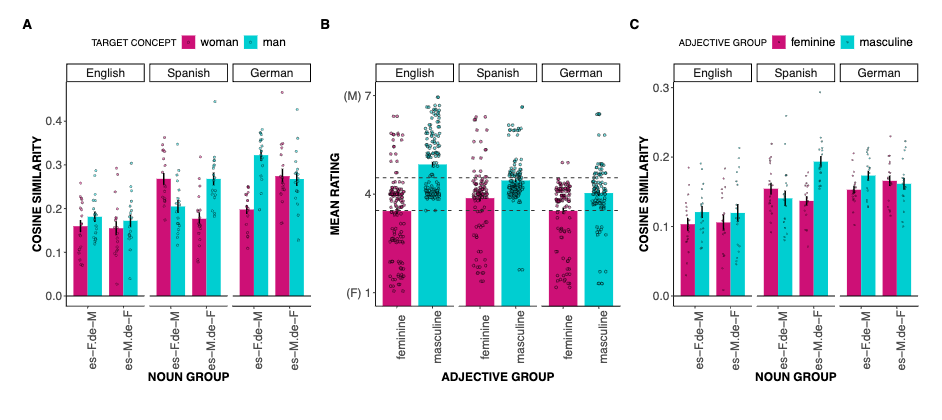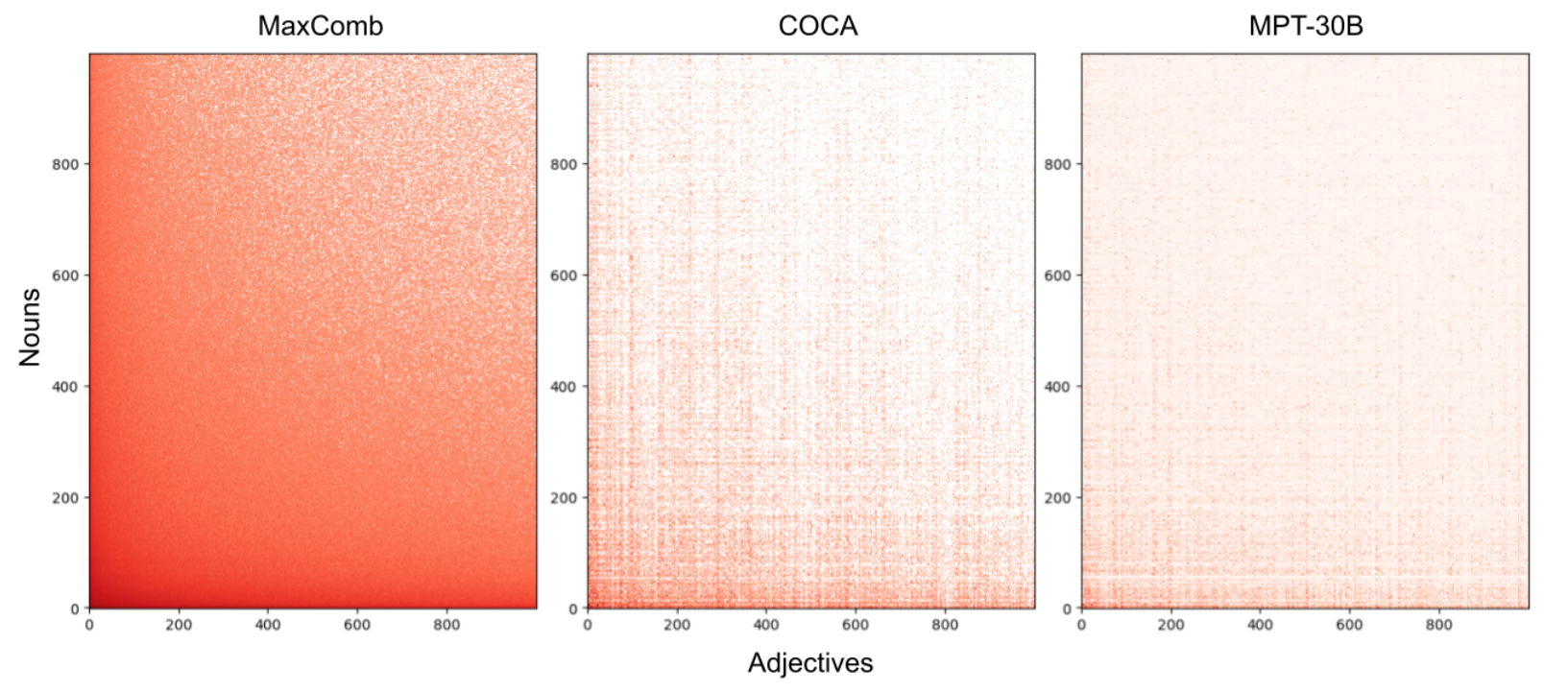Publications
* = senior author
Quantifying Phonosemantic Iconicity Distributionally in 6 Languages
George Flint, Kaustubh Kislay
Language is, as commonly theorized, largely arbitrary. Yet, systematic relationships between phonetics and semantics have been observed in many specific cases. To what degree could those systematic relationships manifest themselves in large scale, quantitative investigations--both in previously identified and unidentified phenomena? This work undertakes a distributional approach to quantifying phonosemantic iconicity at scale across 6 diverse languages (English, Spanish, Hindi, Finnish, Turkish, and Tamil). In each language, we analyze the alignment of morphemes' phonetic and semantic similarity spaces with a suite of statistical measures, and discover an array of interpretable phonosemantic alignments not previously identified in the literature, along with crosslinguistic patterns. We also analyze 5 previously hypothesized phonosemantic alignments, finding support for some such alignments and mixed results for others.
AACL (nominated for best paper award)
linkPrimitive Linguistic Compositionality in a Hebbian Neural Network
George Flint, Anna Ivanova*

Humans have a powerful ability to generate novel compositional representations. For example, imagining a pink banana requires compositional mappings between signifiers pink and banana and the perceptual referents of these signifiers. This essential cognitive faculty remains challenging to model in a biologically plausible way. Here, we present a model that implements signifier-referent compositional associations using Hebbian associative learning. The model satisfies the following constraints: (1) once associated, both signific and referential inputs can activate the shared representation, and (2) when signific and referential inputs are compositional, the model should generalize to novel compositional combinations. When trained on MNIST, the model successfully learns to associate number labels with corresponding images. On colored MNIST, the model learns signific-referential associations for both digits and colors, with somewhat successful generalization to new digit-color combinations. This work serves as a proof of concept for biologically plausible models of signifier-referent association.
Proceedings of the Annual Meeting of the Cognitive Science Society
linkTesting a Distributional Semantics Account of Grammatical Gender Effects on Semantic Gender Perception
George Flint, Anna Ivanova

One well-known prediction of linguistic relativity theories is the effect of a noun’s grammatical gender on its semantics; for instance, ”key” is feminine in Spanish but masculine in German and thus might be associated with feminine traits for Spanish speakers but with masculine traits for German speakers. Experimental and corpus evidence for these effects has been mixed. In this work, we considered a distributional semantics account of putative grammatical gender effects on semantics and tested its predictions in Spanish, German, and English (control). In Part 1, we hypothesized that grammatical gender of concrete nouns affects the similarity of noun embeddings to embeddings of adjectives semantically associated with men or with women. We found support for this hypothesis in fastText embeddings, showing that nouns with the same meaning but with opposite genders in Spanish and German show opposite attraction effects both for words ”man” and ”woman” and for adjectives associated with men and women, although the effect size was weaker for German than for Spanish. BERT embeddings also showed consistent effects for Spanish but mixed results for German, suggesting possible variation across languages. In Part 2, we asked whether people systematically choose adjectives associated with women/men for grammatically feminine/masculine nouns, respectively. In a noun-adjective matching experiment (432 participants total), we found predicted grammatical gender effects for Spanish but not for German. Cosine similarity between the noun and the adjectives in fastText embeddings significantly predicted trial-level responses in all 3 languages; however, Spanish showed an additional effect of grammatical gender, indicating that participant noun-adjective associations are not fully explained by distributional semantics.
Proceedings of the Annual Meeting of the Cognitive Science Society
linkLanguage use is only sparsely compositional: The case of English adjective-nounphrases in humans and large language models
Aalok Sathe, George Flint, Evelina Fedorenko,* Noga Zaslavsky*

Compositionality is considered a key hallmark of human language. However, most research focuses on item-level compositionality, e.g., to what extent the meanings of phrases are composed of the meanings of their sub-parts, rather than on language-level compositionality, which is the degree to which possible combinations are utilized in practice during language use. Here, we propose a novel way to quantify the degree of language-level compositionality and apply it in the case of English adjective-noun combinations. Using corpus analyses, large language models, and human acceptability ratings, we find that (1) English only sparsely utilizes the compositional potential of adjective-noun combinations; and (2) LLMs struggle to predict human acceptability judgments of rare combinations. Taken together, our findings shed new light on the role of compositionality in language and highlight a challenging area for further improving LLMs.
Proceedings of the Annual Meeting of the Cognitive Science Society
linkSumudu Neural Operator for ODEs and PDEs
Ben Zelenskiy, Saibilila Abudukelimu, George Flint*, Kevin Zhu*, Sunishchal Dev*

We introduce the Sumudu Neural Operator (SNO), a neural operator rooted in the properties of the Sumudu Transform. We leverage the relationship between the polynomial expansions of transform pairs to decompose the input space as coefficients, which are then transformed into the Sumudu Space, where the neural operator is parameterized. We evaluate the operator in ODEs (Duffing Oscillator, Lorenz System, and Driven Pendulum) and PDEs (Euler-Bernoulli Beam, Burger's Equation, Diffusion, Diffusion-Reaction, and Brusselator). SNO achieves superior performance to FNO on PDEs and demonstrates competitive accuracy with LNO on several PDE tasks, including the lowest error on the Euler-Bernoulli Beam and Diffusion Equation. Additionally, we apply zero-shot super-resolution to the PDE tasks to observe the model's capability of obtaining higher quality data from low-quality samples. These preliminary findings suggest promise for the Sumudu Transform as a neural operator design, particularly for certain classes of PDEs.
AAAI Workshop on AI to Accelerate Science and Engineering
linkEvaluating K-Fold Cross Validation for Transformer Based Symbolic Regression Models
Kaustubh Kislay, Shlok Singh, Soham Joshi, Rohan Dutta, Jay Shim, George Flint*, Kevin Zhu*

Symbolic Regression remains an NP-Hard problem, with extensive research focusing on AI models for this task. Transformer models have shown promise in Symbolic Regression, but performance suffers with smaller datasets. We propose applying k-fold cross-validation to a transformer-based symbolic regression model trained on a significantly reduced dataset (15,000 data points, down from 500,000). This technique partitions the training data into multiple subsets (folds), iteratively training on some while validating on others. Our aim is to provide an estimate of model generalization and mitigate overfitting issues associated with smaller datasets. Results show that this process improves the model's output consistency and generalization by a relative improvement in validation loss of 53.31%, potentially enabling more efficient and accessible symbolic regression in resource-constrained environments.
Preprint (ArXiv)
linkTesting Evolutionary and Reinforcement Learning Approaches to Traffic Flow Optimization in SUMO
Dominic Domingo, Aryan Bandi, Arya Kunisetty, Ahan Banerjee, George Flint*, Kevin Zhu*
%2016.55.34.png)
Urban road systems require intricate planning to ensure safe and efficient transportation. Effective road systems help reduce traffic congestion, maximize throughput, and minimize collisions. Previous applications of machine learning algorithms to this topic have largely been focused on prediction, not optimization. In this work, we train and evaluate evolutionary and reinforcement learning models on this optimization problem by interfacing with the Simulation of Urban Mobility (SUMO) package. SUMO offers a framework to model and evaluate traffic dynamics, allowing users to configure parameters to explore the effect of various configurations on evaluation metrics. Models set values for traffic signal timings, speed limits, and designated lane access across a road network. They are evaluated on metrics for vehicle throughput, total waiting time, total travel time, speed variation, and crash frequency. We observe performance improvements compared to configurations that estimate the corresponding real-world networks, indicating evolutionary and reinforcement learning approaches might be well suited for this task, despite sparse application thus far.
AAAI Workshop on AI for Urban Planning
link
Copyright © 2025 George Flint - All rights reserved.